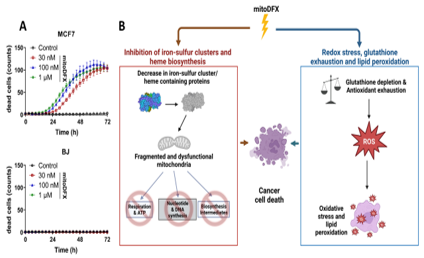Challenge
A major drawback of most anti-cancer drugs is the fact that they indiscriminately affect proliferating cells. Targeting drugs specifically to cancer cells might help reduce drug doses and limit known side effects. Conventional iron chelators that exhibit anti-cancer properties have not been designed to specifically target cancer cells. Moreover, their systemic biodistribution and ability to cross membranes is frequently far from ideal. Thus, despite their reported efficacy on cancer cells in vitro, these compounds significantly interfere with systemic iron metabolism in vivo. Therefore, the development of new cancer-selective iron chelators has been a challenge that we have solved by targeting iron chelator deferasirox into mitochondria.
Innovation
MitoDFX, our new chemical entity, specifically targets highly polarized mitochondria of cancer cells, alters their iron metabolism and thus selectively kills cancer cells. The design of the molecule allows for implementing the “dual nature of iron”, where our asset mitoDFX is able to bind the iron and suspend iron-dependent cellular processes but at the same time generate iron-induced oxidative damage to the cancer cells, leading to exhaustion of their antioxidant defense and ultimately their demise - cell death.
Our POC studies demonstrated that the mitochondria-targeting approach is effective against melanoma and breast cancer, including triple negative breast cancer, both in vitro and in vivo. It is also effective against pancreatic cancer in vitro. Due to its ability to suppress migration of the cells MitoDFX is expected to also prevent metastatic spread, a major problem in many cancers. Due to the vital role of iron in many cellular processes, cancer cells are unlikely to be able to develop resistance to this treatment. MitoDFX is well tolerated in experimental animals and allows for oral administration. No adverse effects on systemic iron metabolism and erythropoiesis have been observed.

Figure 1. A: Specific induction of cell death by mitoDFX in malignant cancer cells (MCF7) is effective at 30 nM while there is no effect on non-malignant cells (BJ) up to 1 µM. B: Mode of action of mitoDFX involves (I) deprivation of iron and (II) oxidative damage coupled with depletion of glutathione.
Commercial Opportunities
Attractive indications in cancer treatment with high unmet needs such as melanoma or pancreatic cancer. Furthermore, the compound could, in theory, be a pharmacophore of a radioactive radioligand due to its chelating properties, and thus could be suitable for theranostics: diagnostics based on radioimaging and treatment by radiotherapy.
Development Status
POC studies on lead compound ready (in vivo test for pancreatic cancer coming).
Aiming to enter pre-clinical studies.
| Your Contact |
| Martina Plisova, Ph.D. |
| tto@ibt.cas.cz |
| +420 325 873 340 |
